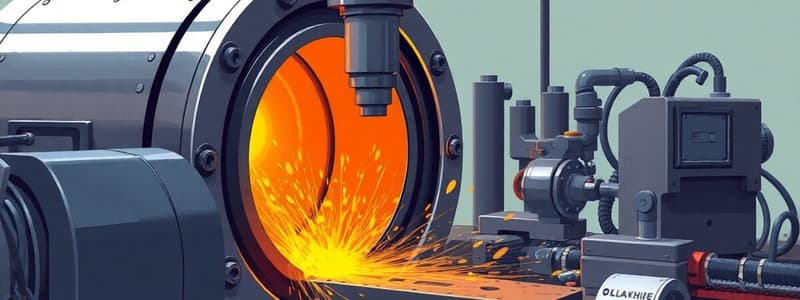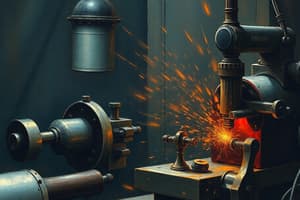Podcast
Questions and Answers
What factors must be selected to determine the inputs to the turning and boring processes?
What factors must be selected to determine the inputs to the turning and boring processes?
- Material type and tool material
- Surface finish and coolant type
- Cutting speed, feed rate, and depth of cut (correct)
- Depth of cut and cutting speed
How is the rpm (Ns) of the rotating workpiece determined?
How is the rpm (Ns) of the rotating workpiece determined?
- By calculating with the desired cutting speed (correct)
- Using the smaller diameter of the workpiece
- By selecting the material hardness
- Using the cutting tool length
Which unit is used to express feed rate in the turning process?
Which unit is used to express feed rate in the turning process?
- Feet per minute
- Revolutions per minute
- Inches per revolution (correct)
- Inches per minute
What additional distance does the length of cut account for aside from the distance traveled parallel to the axis?
What additional distance does the length of cut account for aside from the distance traveled parallel to the axis?
When calculating cutting time, what variables are considered?
When calculating cutting time, what variables are considered?
What is the primary role of selecting cutting speed in the machining process?
What is the primary role of selecting cutting speed in the machining process?
Why is it essential to select the correct depth of cut in the turning process?
Why is it essential to select the correct depth of cut in the turning process?
What conversion factor is used to change feet to inches in the rpm calculation?
What conversion factor is used to change feet to inches in the rpm calculation?
What is a key function of coolants in the drilling process on a lathe?
What is a key function of coolants in the drilling process on a lathe?
What is the purpose of peck drilling in deep hole drilling?
What is the purpose of peck drilling in deep hole drilling?
Which of the following best describes the primary function of lathes?
Which of the following best describes the primary function of lathes?
Why is understanding machine tool terminology important?
Why is understanding machine tool terminology important?
What type of machine tool is most commonly associated with turning processes?
What type of machine tool is most commonly associated with turning processes?
Which of the following operations can lathes perform besides turning?
Which of the following operations can lathes perform besides turning?
In which position is the drill typically mounted on a lathe during drilling operations?
In which position is the drill typically mounted on a lathe during drilling operations?
What is a primary reason for using lathes over other machine tools for turning?
What is a primary reason for using lathes over other machine tools for turning?
What does the metal removal rate (MRR) assume about the depth of cut in turning or boring?
What does the metal removal rate (MRR) assume about the depth of cut in turning or boring?
What is the primary purpose of the boring process?
What is the primary purpose of the boring process?
What type of hole can be created through the boring process?
What type of hole can be created through the boring process?
During the boring process, what is a common tool employed?
During the boring process, what is a common tool employed?
Which of the following statements about the cutting time in boring is accurate?
Which of the following statements about the cutting time in boring is accurate?
What does D1 represent in the context of the metal removal rate calculations?
What does D1 represent in the context of the metal removal rate calculations?
How is the cutting time for a boring process determined?
How is the cutting time for a boring process determined?
In manufacturing processes, what does the term 'overrun allowance' refer to?
In manufacturing processes, what does the term 'overrun allowance' refer to?
What does the term 'swing' refer to in lathe size designation?
What does the term 'swing' refer to in lathe size designation?
Which component of the lathe provides manual and powered motion for the carriage?
Which component of the lathe provides manual and powered motion for the carriage?
Which type of lathe is most commonly used in manufacturing?
Which type of lathe is most commonly used in manufacturing?
What is the primary function of the tool post mounted on the compound rest?
What is the primary function of the tool post mounted on the compound rest?
Which of the following lathes is classified as a type of lathe used in manufacturing?
Which of the following lathes is classified as a type of lathe used in manufacturing?
The maximum distance between centers in a lathe refers to what?
The maximum distance between centers in a lathe refers to what?
What type of mechanism allows the compound rest to rotate and translate?
What type of mechanism allows the compound rest to rotate and translate?
What is a unique feature of engine lathes compared to other types of lathes?
What is a unique feature of engine lathes compared to other types of lathes?
What is the primary benefit of using quick-change tool holders in lathe operations?
What is the primary benefit of using quick-change tool holders in lathe operations?
Which workholding method does NOT involve rotating the workpiece during machining?
Which workholding method does NOT involve rotating the workpiece during machining?
In turret-lathe tooling, what is the purpose of operation 3 as indicated in the manufacturing sequence?
In turret-lathe tooling, what is the purpose of operation 3 as indicated in the manufacturing sequence?
What percentage of total cycle time may tool changing and setting take in lean manufacturing with lathes?
What percentage of total cycle time may tool changing and setting take in lean manufacturing with lathes?
Which of the following statements regarding the turret-lathe tooling setup is accurate?
Which of the following statements regarding the turret-lathe tooling setup is accurate?
How does a quick-change tool post enhance lathe productivity during operations?
How does a quick-change tool post enhance lathe productivity during operations?
What is one disadvantage of mounted workpieces on the carriage in lathe operations?
What is one disadvantage of mounted workpieces on the carriage in lathe operations?
Which of these is NOT a commonly used method for supporting workpieces in lathes?
Which of these is NOT a commonly used method for supporting workpieces in lathes?
Flashcards are hidden until you start studying
Study Notes
Fundamentals of Turning, Boring, and Facing Turning
- Turning, Boring, and Facing Processes use a single-point cutting tool to machine a workpiece.
- Cutting speed (V), feed rate (fr), and depth of cut (d) determine the inputs needed for turning.
- Cutting speed is measured in feet per minute and determines the revolutions per minute (rpm) of the workpiece.
- Feed rate is measured in inches per revolution and determines the amount of material removed with each revolution.
- Depth of cut is the amount of material removed in each pass.
- The length of cut includes the distance traveled parallel to the axis (L) and an allowance or overrun (A) to allow for tool entry and exit.
- Cutting time can be calculated using the formula: T = (L + A) / fr.
- Metal removal rate (MRR) is the volume of material removed per unit of time, approximated by: MRR = π/4 * d * D1 * fr * V.
- It is important to select the right cutting speed, feed rate, and depth of cut to ensure efficient machining and prevent damage to both the tool and the workpiece.
Boring
- Boring is the process of enlarging an existing hole.
- Holes can be bored straight, tapered, threaded, or to irregular contours.
- The cutting time for boring can be calculated as: T = (L + A) / fr.
- Where D1 is the diameter of the bore and A is the overrun allowance.
- The metal removal rate for boring can be calculated as: MRR = π/4 * d * (D1^2 - D2^2) * fr * V.
- Where D2 is the original hole diameter.
Drilling
- Drilling on lathes can be done with the drill mounted in the tailstock quill or turret.
- Coolants should be used when drilling to prevent overheating and improve tool life.
- Peck drilling is used for deep holes to clear chips and allow coolant to reach the cutting edges.
Lathe Design and Terminology
- Lathes are machine tools designed for turning, facing, and boring.
- The tool post is mounted on a compound rest, which allows for precise tool positioning.
- The carriage is moved parallel to the ways by turning a handwheel on the front of the apron.
- Lathe size is designated by swing (maximum diameter of work) and distance between centers.
- Lathe types include speed, engine, toolroom, turret, automatics, tracer, and numerical control turning centers.
- Engine lathes are the most common and have power drive for all tool movements except on the compound rest.
Cutting Tools for Lathes
- Quick-change tool holders reduce tool-changing time in lean manufacturing cells.
- Turret-lathe tooling setup involves a sequence of operations to machine a workpiece.
- Each operation is assigned to a specific tool and position on the turret.
Workholding in Lathes
- Five common methods for supporting workpieces in lathes are:
- Held between centers
- Held in a chuck
- Held in a collet
- Mounted on a faceplate
- Mounted on the carriage
- In the first four methods, the workpiece is rotated during machining.
- In the fifth method, the tool rotates while the workpiece is fed into the tool.
Studying That Suits You
Use AI to generate personalized quizzes and flashcards to suit your learning preferences.



